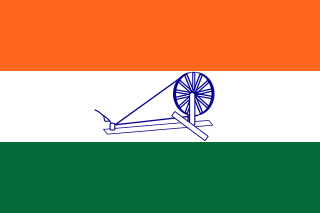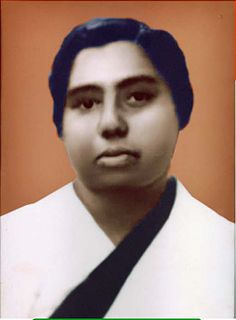Related Research Articles

The Indian independence movement was a series of historic events with the ultimate aim of ending British rule in India. It lasted from 1857 to 1947.

The Indian National Army was an armed force formed by Indian collaborators and Imperial Japan on 1 September 1942 in Southeast Asia during World War II. Its aim was to secure Indian independence from British rule. It fought alongside Japanese soldiers in the latter's campaign in the Southeast Asian theatre of WWII. The army was first formed in 1942 under Rash Behari Bose by Indian PoWs of the British Indian Army captured by Japan in the Malayan campaign and at Singapore. This first INA, which had been handed over to Rash Behari Bose, collapsed and was disbanded in December that year after differences between the INA leadership and the Japanese military over its role in Japan's war in Asia. Rash Behari Bose handed over INA to Subhas Chandra Bose. It was revived under the leadership of Subhas Chandra Bose after his arrival in Southeast Asia in 1943. The army was declared to be the army of Bose's Arzi Hukumat-e-Azad Hind. Netaji Subhas Chandra Bose named the brigades/regiments of INA after Gandhi, Nehru, Maulana Azad, and himself. There was also an all-women regiment named after Rani of Jhanshi, Lakshmibai. Under Bose's leadership, the INA drew ex-prisoners and thousands of civilian volunteers from the Indian expatriate population in Malaya and Burma. This second INA fought under the Imperial Japanese Army against the British and Commonwealth forces in the campaigns in Burma: at Imphal and Kohima, and later against the Allied retaking of Burma.

The Communist Party of India (CPI) is the oldest communist party in India and one of the eight national parties in the country. The CPI was founded in modern-day Kanpur on 26, December 1925.
Events in the year 1948 in India.

Bundelkhand is a geographical and cultural region and a proposed state and also a mountain range in central & North India. The hilly region is now divided between the states of Uttar Pradesh and Madhya Pradesh, with the larger portion lying in the latter state.

Jhansi is a historic city in the Indian state of Uttar Pradesh. It lies in the region of Bundelkhand on the banks of the Pahuj River, in the extreme south of Uttar Pradesh. Jhansi is the administrative headquarters of Jhansi district and Jhansi division. Also called the Gateway to Bundelkhand, Jhansi is situated near and around the rivers Pahuj and Betwa at an average elevation of 285 m (935 ft). It is about 420 kilometres (261 mi) from New Delhi and 102 kilometres (63 mi)from Gwalior.

Basanta Kumar Biswas was an Indian pro-independence activist involved in the Jugantar group who, in December 1912, played a role in the bombing of the Viceroy's parade in what came to be known as the Delhi-Lahore Conspiracy.
The Revolutionary movement for Indian Independence was the part of the Indian independence movement comprising the actions of violent underground revolutionary factions. Groups believing in armed revolution against the ruling British fall into this category, as opposed to the generally peaceful civil disobedience movement spearheaded by Mohandas Karamchand Gandhi. The revolutionary groups were mainly concentrated in Bengal, Maharashtra, Bihar, the United Provinces and Punjab. More groups were scattered across India.

The Ministry of Home Affairs, or simply the Home Ministry, is a ministry of the Government of India. As an interior ministry of India, it is mainly responsible for the maintenance of internal security and domestic policy. The Home Ministry is headed by Union Minister of Home Affairs Amit Shah.
The Indian Independence League was a political organisation operated from the 1920s to the 1940s to organise those living outside India into seeking the removal of British colonial rule over India. Founded by Indian nationalists, its activities were conducted in various parts of Southeast Asia. It included Indian expatriates, and later, Indian nationalists in-exile under Japanese occupation following Japan's successful Malayan Campaign during the first part of the Second World War. During the Japanese Occupation of Malaya, the Japanese encouraged Indians in Malaya to join the League.

The Indian National Army trials was the British Indian trial by court-martial of a number of officers of the Indian National Army (INA) between November 1945 and May 1946, on various charges of treason, torture, murder and abetment to murder, during the Second World War. In total, approximately ten court-martials were held. The first of these was the joint court-martial of Colonel Prem Sahgal, Colonel Gurbaksh Singh Dhillon, and Major-General Shah Nawaz Khan. The three had been officers in the British Indian Army and were taken prisoner in Malaya, Singapore and Burma. They had, like a large number of other troops and officers of the British Indian Army, joined the Indian National Army and later fought in Burma alongside the Japanese military under the Azad Hind.

Comrade Achhar Singh Chhina was an Indian communist politician and independence activist. He served as a MLA in the Punjab Legislative Assembly for two terms. In 1962, he contested the Member of Parliament (MP) election from Taran Taran and was defeated by 1990 votes.
The Harsha Chhina Mogha Morcha was an agrarian revolt in Harsha Chhina, Punjab, India, that took place in 1946 under the leadership of the Communist Party of India. Harsha Chhina is a village near RajaSansi Airport, Amritsar.The Morcha started in response to a decision taken by the British Government to decrease the supply of irrigation water to farmers by remodelling the moghas. The Morcha was headed by Comrade Achhar Singh Chhina, Sohan Singh Josh, Mohan Singh Baath, Baba Karam Singh Cheema, Jagbir Singh Chhina, and Gurdial Singh Tapiala. On the afternoon of 16 July 1946, Achhar Singh Chhina led a Jatha of 15 members from Harcha Chhina Village. On his shoulders he carried an Iron Kahi. The declared aim was to remove one of the existing outlets placed by the canal department and substitute it with the bigger outlet carried by the Jatha. The Jatha, whose members carried their respective party flags, proceeded toward the Canal distributary, followed by the big crowd. Before they could reach the canal, the police stepped in, arrested them and whisked them away to Amritsar. The pattern was repeated on subsequent days as well. During this movement 950 freedom fighters were arrested by police and detained in Lahore jail for three months.
Harsha Chhina is a village in the state of Punjab, India, three kilometers from Sri Guru Ram Dass Jee International Airport, Amritsar, on Ajnala Road. Harse is an Urdu word which means three villages. It is one of biggest villages in Ajnala and Rajasansi Constituency. It has a population of about 6,500. Until 1968 the village had one Panchayat and thereafter each sub village got respective new Panchayats. However, now there is another sub village Kukranwala with independent panchayat that has evolved from this village. Harsha Chhina, previously under Block Development Office Chogawan, has now itself become a new Block Development Office, situated in Kukranwala. Harsha Chhina is also referred as Chhine The Wale, because there used to be an ancient, huge and tall mountain-like structure known as The in Punjabi, situated about half a kilometre west of Vichla Quila. This The was visible from surrounding villages in an approximately 10-kilometre radius. Unfortunately this prominent feature, which existed until the late 1990s, has disappeared, as it has been mercilessly leveled and illegally occupied by the neighbouring farmers.

Akkamma Cherian was an Indian independence activist from Travancore (Kerala), India. She was popularly known as the Jhansi Rani of Travancore.

Jagbir Singh Chhina (1920-2012) was a freedom fighter who worked during the freedom movement with Comrade Achhar Singh Chhina, Pratap Singh Kairon, Sohan Singh Josh, Mohan Singh Batth, Gurdial Singh Dhillon and Harkishan Singh Surjeet against the British empire. He has served the community since 1938 as an active member of society.

Govinddas Mannulal Shroff (1911–2002), was an Indian freedom fighter who led people of Marathwada region in a fight against the Nizam of Hyderabad during the Hyderabad Campaign of 1948. As a result, the Marathwada region was liberated from the Hyderabad State on 17 September 1948.
The Kadakal Rebellion of 1938 or Kadakkal Revolt was a civil disobedience movement that happened against unfair toll collection in Kadakkal of Kollam district in the course of India's struggle. It is a unique event in the history of the princely state of Travancore. The event which started as a mass movement against excess tax or toll collection by authorities eventually culminated in the formation of a parallel administration named Kummil Pakuthi, perhaps the smallest in the world lasting for a short span of eight days. The event is also known as Kadakkal Riot Case and is recognized as an Indian independence movement by Ministry of Home Affairs (India).

Captain Laxmi Indira Panda was an Indian revolutionary and one of the youngest members of Netaji Subash Chandra Bose's Indian National Army. Panda was the only Odia woman to serve in the INA.

The Indian independence movement was a series of historic events with the ultimate aim of ending British rule in India, lasting from 1857-1947. Women played a pivotal role in achieving India's independence. However, their lives, struggles, and contributions to the movement are never recognized at the same level of prominence as that of the men of the movement. Additionally, their names are seldom heard when discussing the independence movement, or mentioned in brief. Woman’s participation in India’s freedom struggle started as early as 1817. Bhima Bai Holkar fought against the British Colonel Malcolm and defeated him in guerrilla warfare. Throughout the twentieth century, numerous women continued to contribute to the movement through military leadership, political leadership, and social activism.
References
- ↑ http://www.mha.nic.in/annual-2002-2003/ch-2.pdf%5B%5D
- ↑ "Swathantra Sainik Samman Pension Scheme" (PDF). Archived from the original (PDF) on 2007-07-05. Retrieved 2021-08-07.
- 1 2 3 The Hindu. (22 August 2006) Centre asked to pay pension to freedom fighter's widow. [Usurped!]
- 1 2 "Archived copy" (PDF). Archived from the original (PDF) on 2011-07-16. Retrieved 2010-05-14.
{{cite web}}: CS1 maint: archived copy as title (link) - ↑ Pensioners Portal
